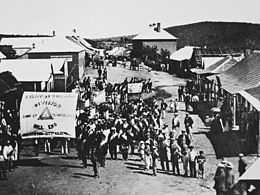Temperance movement in Australia
The Temperance movement in Australia was a movement that aimed to curb the drinking of alcohol. It had some success in the early twentieth century although from the Second World War its influence declined.

In Australia, the temperance movement began in the mid-1830s, promoting moderation rather than abstinence. The Independent Order of Rechabites was active in promoting temperance in Australia from the 1870s and in Sydney, the Australian Home Companion and Band of Hope Journal was published between 1856 and 1861.
In the 1880s, a significant number of hotels around the country were built as or converted to coffee palaces, where no alcohol would be served. With the waning of the influence of the temperance movement, most of these hotels either applied for liquor licenses or were demolished.
In the mid-1880s the US-based Woman's Christian Temperance Union, a more successful abstinence-oriented movement, set up a branch in Australia.[1] The inaugural President of the federated Australasian Woman's Christian Temperance Union (WCTU) was Jessie Ackermann, who visited the country in 1889, 1891 and 1894. However, the movement failed to bring about prohibition, as happened in the United States, despite a long campaign for a local option. Both the Woman's Christian Temperance Union and the Rechabites achieved a major success when during World War I they were successful in bringing in mandatory closure of hotel bars and public houses at 6 pm, from the previous norm of 11 or 11.30 pm.[2]
The first state to introduce early closing was South Australia in 1915 as a war austerity measure. Six o'clock closing was adopted in New South Wales, Victoria and Tasmania in 1916. It was introduced in New Zealand in 1917. Western Australia adopted a 9pm closing time, but Queensland retained the old closing times until it introduced eight o'clock closing in 1923.[2]
Alcohol was originally banned in Canberra but was made legal again following a plebiscite in 1928.[3][4]
In any case, the law was a failure; sports and cosmopolitan workingmens clubs were considered private bars and were allowed to trade alcohol until very late and patrons would usually buy alcohol from off-licences to consume at home or at parties after the six o'clock swill. Early public house closing times did not have a significant effect on reducing alcohol consumption levels.[2] Six o'clock closing led to the notorious six o'clock swill where customers would rush to drinking establishments after work and consume alcohol heavily and rapidly in anticipation of the 6 o'clock closing. Early hotel closing times began being wound back from the 1950s, with the last Australian state, South Australia, doing so in 1967. New Zealand followed suit after it held a referendum on the subject in that same year which provided overwhelming support for expansion of closing time within its pubs.
A legacy of the temperance movement are Melbourne's “dry areas” where residents must vote to approve liquor licences in the area. These areas are small pocket of about a dozen suburbs in the eastern suburbs, which are subject to such severe restrictions on the issuing of liquor licences that they are without any pubs and limited other licensed venues. In the 1920s, local opinion polls were taken and residents of these areas voted for the creation of a dry area.[5]
See also
References
- ↑ Tyrrell, Ian. "Ackermann, Jessie A. (1857–1951)". Australian Dictionary of Biography. Australian National University. Retrieved 17 October 2011.
- ↑ 2.0 2.1 2.2 Phillips, Walter (1980). "'Six o'clock swill': the introduction of early closing of hotel bars in Australia". Historical Studies (University of Melbourne) 19 (75): 250–266. doi:10.1080/10314618008595637. Retrieved 2012-08-18.
- ↑ http://www.nationalcapital.gov.au/index.php?option=com_content&view=article&id=253&Itemid=247
- ↑ http://www.canberratimes.com.au/act-news/ditty-details-end-of-drink-drought-20120805-23o1g.html
- ↑ Crikey.com.au 16 February 2011